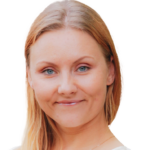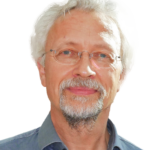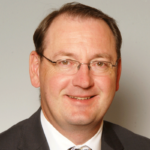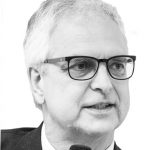
Welcome
and
Introduction
Andreas Rauscher
Chairman of INGEDE
Abstract & Biography here

Wake-up call: Print product as eco-offender vs. a "clean" digital world? Myths, facts, and opinions
Anne-Katrin Kohlmorgen
TwoSides Germany
Fibre-based packaging made from renewable raw materials is in many cases a good alternative to plastics or other materials.
A global manufacturer shows how the necessary functions of packaging can be developed with innovative solutions that are also easy to recycle.
Jürgen Dornheim
Director Corporate Packaging Innovation & Sustainability at Procter & Gamble
Jürgen Dornheim has worked for Procter & Gamble and Gillette in the non-food brand business for 33 years.
For 8 years Head of Global Packaging Development for two leading global brands: Oral-B and Braun.
Since 2013 working at global corporate level on packaging innovation and circular economy for all brands with a strong focus on innovation, sustainability and new materials.
Focus on fibre-based packaging, with technical innovations in the area of new properties and good recyclability. Introduction of numerous award-winning fibre packaging.
Active outside P&G as an expert in 4evergreen, in the European paper industry, and until 2023 as an expert for the German “minimum standard”.

How does the Commission proposal affect the recycling industry, especially the deinkers?
Ulrich Leberle
CEPI, Brussels
The new EU Packaging Regulation and possible effects on paper recycling
The European Commission presented its proposals for an EU packaging regulation at the end of 2022. This had already been discussed at the last INGEDE Symposium. In the meantime, the various proposals on reusable quotas, packaging reduction and bans on certain types of packaging have been discussed, some of them very controversially.
However, the European Parliament and the member states are still far apart in some areas. Recyclability and its assessment, as well as requirements for closed-loop recycling and minimum recyclate requirements are also still being discussed – an agreement might be reached in March 2024. The presentation will look at the latest status and possible effects on paper recycling.
Ulrich Leberle was born in 1975 in Nördlingen, Germany.
He holds Master degrees in history from the Universities of Tübingen (Germany) and Aix-en-Provence (France).
After professional experiences in the European Commission, the European Parliament and as a consultant in a Brussels-based company specialising in EU Public Affairs, he joined the Confederation of European Paper Industries (Cepi) in November 2005. Having held several positions in the area of raw materials at Cepi, his responsibilities in his current role of Raw Materials Director include the availability of raw material both from forestry and recycling and the policies impacting them.

The future of fibre-based product packaging from the perspective of a global manufacturer
Jürgen Dornheim
Procter & Gamble
Fibre-based packaging made from renewable raw materials is in many cases a good alternative to plastics or other materials.
A global manufacturer shows how the necessary functions of packaging can be developed with innovative solutions that are also easy to recycle.
Jürgen Dornheim
Director Corporate Packaging Innovation & Sustainability at Procter & Gamble
Jürgen Dornheim has worked for Procter & Gamble and Gillette in the non-food brand business for 33 years.
For 8 years Head of Global Packaging Development for two leading global brands: Oral-B and Braun.
Since 2013 working at global corporate level on packaging innovation and circular economy for all brands with a strong focus on innovation, sustainability and new materials.
Focus on fibre-based packaging, with technical innovations in the area of new properties and good recyclability. Introduction of numerous award-winning fibre packaging.
Active outside P&G as an expert in 4evergreen, in the European paper industry, and until 2023 as an expert for the German “minimum standard”

Consequences from the change in the composition
of paper for recycling
Johannes Rahm
AFRY Management Consulting
Abstract & Biography here

Fibre composites in the
paper recycling loop
Jürgen Belle and Daniela Hirtz
Munich University of Applied Sciences
Less and less paper for recycling is available for the production of recycled paper, and paper companies are constantly closing down mills that process it. What is the raw material that is available today and what can be effectively produced from it?
Fibre composites in the recovered paper cycle – results of an expert survey
Jürgen Belle and Daniela Hirtz
The presentation deals with the question of whether the increasing proportion of fibre-based composites is leading to noticeable changes in sorting quality and the composition of the individual fractions, as well as whether current laws and processes are having an impact on this. This topic is frequently discussed and described at trade fairs and conferences. An analysis and evaluation of the German recycling industry on this issue could not be found. For this reason, empirical data was collected in order to answer the question.
Various companies in the sorting and recycling industry were interviewed in the survey.
The basic population of companies was defined as follows:German companies that collect, sort and deliver waste paper to paper mills.All company sizes (micro companies < 10 employees, SMEs 10-250 employees, large companies with more than 250 employees) and companies that obtain waste paper from the following sources (blue bin, municipal disposal, commercial waste, graphics industry, yellow bag/bin) are relevant.The central question to be answered by the survey is whether fibre-based composites lead to problems in production and whether the current laws and procedures have an influence on this.
The following question categories were chosen to answer these questions:
- Company size and type of products
- Observations on the composition of the waste paper
- Source of waste paper and sorting
Fibre-based composites - Problematic substances in production
Selected details of the extensive survey are presented to the audience and put up for discussion.
CV
Dr Jürgen Belle is Professor of Process Engineering in Paper and Board Production at Munich University of Applied Sciences. He began his career in the paper industry with a successful apprenticeship as a papermaker at Nordland Papier GmbH, Dörpen. In 1995, he completed his engineering studies (Dipl.-Ing. FH) at the Munich University of Applied Sciences. As an engineer, he took on various tasks in production, research, training and consultancy. His doctorate focussed on the initial wet strength of paper and was carried out in cooperation with the University of Hamburg.
Prof. Dr. Jürgen Belle is currently primarily concerned with the use of fibres from waste paper for different types of paper and cardboard, pulping and the influence of the interactions of process water ingredients on paper quality.

Certification of sorting plants (ZAPSA): What have we learnt from the project?
Arne Krolle
PROPAKMA
Is the sorting of paper for recycling currently a stable, innovation-friendly business model? How can new technologies compensate for rising operating costs and the deterioration of paper from household collections?
The ZAPSA project:
The requirement for quality assurance in the sorting of paper for recycling applies both on the part of the CEPI and in the draft for the end-of-waste properties from the EU in 2013. The establishment of systematic process control is much easier to achieve through the introduction of new technologies in paper for recycling sorting. In particular, online measurement by AI-supported systems enables adaptation to changes in the composition of paper for recycling to improve the yield and quality of deinking material and secure the sorting business model. The project combines current technical development with customised process control. This development is intended to reduce transaction costs and forms the basis for digitalising the value chain.

Rejects from the recycling of paper from mixed waste collections: Analysis and potentials
Alena Maria Spies and Hannah Köhler
RWTH Aachen
Rejects from the recycling of paper from mixed waste collections: Analysis and potentials
Alena Maria Spies and Hannah Köhler
ANTS – Chair of Anthropogenic Material Cycles, RWTH Aachen University
For more than two years, the EnEWA project (energy savings in paper production by tapping into the value chains of waste paper from lightweight packaging, residual waste and commercial waste) has been researching the potential for using paper fibres from mixed waste collections. Previous analyses of paper from these collections show increased proportions of impurities and non-paper compared to separate paper collection. This results in increased reject quantities during paper processing. Within an industrial production trial, analyses of the rejects were carried out. In the presentation, material characterisations of the rejects, the effects on the process balance and an outlook on possible recycling potentials are given.
Alena Maria Spies, M. Sc.
ANTS –Chair of Anthropogenic Material Cycles
RWTH Aachen University
Wüllnerstr. 2
52062 Aachen
Environmental engineer with more than six years of practical experience in the field of waste management.
Research in the area of recycling and waste processing technology. Specialization in the master’s degree in
chemical process engineering. Since June 2022 research associate and doctoral candidate at the Chair of
Anthropogenic Material Cycles (ANTS, RWTH Aachen University).
PROFESSIONAL EXPERIENCE
06/2022 – 03/2024 Research Assistant with a Master’s Degree, RWTH Aachen University
Chair of Anthropogenic Material Cycles (ANTS)
• Management of the EnEWA research project
• Head of the ANTS Technical Center
05/2017 – 11/2021 Research Assistant with a Bachelor’s Degree/Student Assistant, RWTH Aachen University
Chair of Anthropogenic Material Cycles (ANTS) since 09/2020
formerly Institute for Processing and Recycling (I.A.R.)
• Leading position in current research projects
ACADEMIC EDUCATION
11/2019 – 05/2022 Environmental Engineering M.Sc., RWTH Aachen University
Master’s Thesis: Analysis of the material stream “paper” from the collection of mixed
waste streams with regard to recycling options for strengthening a circular economy
10/2015 – 10/2019 Environmental Engineering B.Sc., RWTH Aachen University
Bachelor’s Thesis: Electrochemical conversion from acetoin to 2-butanone
RESEARCH FOCUS
• Recycling of secondary raw material from mixed (municipal) solid waste
• Process development and modelling
• Development of statistical sampling models and procedures
Hannah Köhler, M.Sc.
Chair of Anthropogenic Material Cycles
RWTH Aachen
Wuellnerstraße 2
52062 Aachen
Academic Education:
2019-2022 Environmental Engineering (Specialization Recycling), M. Sc., RWTH Aachen
2015-2019 Environmental Engineering, B. Sc., RWTH Aachen
Professional Experience:
2022-today PhD student and research assistant
Chair of Anthropogenic Material Cycles, RWTH Aachen
• EnEWA research project: Environmental Assessment
2019-2022 Student Assistant
LuF Technology of fuels, RWTH Aachen
• 04/2021 to 03/2022: Laboratory representative
• Leading laboratory student assistants
Research-related experiences:
• Laboratory analysis (Immediate analyses, calorific value, elemental analyses, surface determination)
• Life Cycle Assessment with OpenLCA, Brightway 2.0, Umberto
• Collection of primary data for ecological and economic assessment
Research focus:
• Ecological modelling and assessment of newly developed waste treatment processes
• Modelling and assessing the recycling of paper from mixed waste collections
• Conducting Life Cycle Assessments
• Collection of primary data for Life Cycle Assessments

ODiWiP becomes KIBAPap:
AI-based assistance for operating a paper machine
Hanna Schwandt, Leipa
and Felix Hake, Consultingtalents AG
ODiWiP becomes KIBAPap – Successful application for follow-up funding in the Industrial Bioeconomy funding programme of the Federal Ministry of Economics and Climate Protection (BMWK)
Hanna Schwandt, Leipa, and Felix Hake, Consultingtalents AG
The abbreviation stands for “AI-based operator assistance system in the paper material cycle”.
The ODiWiP research project has successfully developed and implemented a functional demonstrator of an AI-based assistance system for operating a paper machine. This assistance system offers an efficient way of monitoring the production process, recognising and rectifying quality problems at an early stage and preserving the decision-making authority of the machine operators. The self-optimisation function and the option to expand specialist knowledge ensure that the system is continuously improved and meets changing requirements.
This project shows the potential of AI in industry and emphasises the importance of intelligent assistance systems for increasing efficiency and quality in complex production processes. The successful implementation of the demonstrator opens up the possibility for further development and customisation of the assistance system. It is to be expected that this technology will play an increasingly important role in the paper manufacturing industry and beyond in order to optimise production processes and ensure the quality of the end products.
Due to the high relevance and the recognised need for further developments, a follow-up project, “KIBAPap – AI-based operator assistance system in the paper recycling loop”, was initiated. It has been funded since 1 July 2023 as part of the BMWK’s Industrial Bioeconomy funding measure. The aim of this new project, “KIBAPap”, is to further develop the prototype from TRL 6 to a scalable solution (TRL 8). This progress should ensure that the prototype undergoes the necessary maturity and practical tests to ensure successful and sustainable commercial usability.
Matching the topic, KI has also been used to translate this text: with www.DeepL.com/Translator (free version)

Non-wood fibres as alternative raw materials for packaging papers
Fokko Schütt, Thünen Institute
and Friedrich Steffen, Hamburg University
Non-wood fibres as alternative raw materials for packaging papers – Some insights into physical properties and recyclability
Many paper manufacturers consider adding virgin fibres to the recovered paper to produce packaging papers. Approaches range from simply grinding and adding non-wood raw materials such as grass to cooking chemical pulp for example from straw. Recent developments show that valuable fibers can be produced and availabilities of such fibres are likely to rise in the next years.
At the Thünen-Institute and at the University Hamburg, simple pulping technologies have been tested and optimized to produce fibres with relatively high yields and good strength values using sodium carbonate and sodium hydroxide as pulping chemicals. These fibres are tested for strength values as well as for their behaviour in recyclability tests using the Cepi Recyclability Test Method. Furthermore, some commercially available fibres and paper products are being tested and compared. The question is raised, as to whether the method is suitable for appropriately evaluating the use of non-wood fibers.
Dr. Fokko Schütt
Dr. Fokko Schütt studied Wood Science at the University of Hamburg and worked on steam pretreatment and enzymatic hydrolysis of poplar wood during his PhD. In 2012 he joined the PTS (Papiertechnische Stiftung) where he worked for 3 years as a researcher and project leader in the area of resource management and alternative raw materials for paper making. After working in two further positions in product development and project coordination, he joined the Thünen-Institute of Wood Research in 2020. He works in the area of bio-based resources and materials, with a focus on pulp and fibre production and use.

Alternative fibres and processing methods:
Dry defibration
Tilo Gailat
TBP Future GmbH
How can the energy and water requirements of paper production be reduced in order to meet environmental challenges? Dry defibration is an innovative route to a bioeconomy with enormous potential for paper and board production.

Change in the raw material spectrum: hygiene paper from packaging
Stefan Finke
WEPA
Beige is the new green! WEPA produces the first premium-quality recycled tissue paper from packaging cardboard. The unbleached tissue paper is luxuriously soft, particularly absorbent and hygienically safe in all areas of application from towel and toilet paper to kitchen rolls.
Since 2006/2007, the production of newsprint, magazine printing and writing paper in Europe has been shrinking steadily. We assume that, according to the figures for 2023, European manufacturers will have produced only 35 percent of this volume in Europe last year.
True to the motto “What is not produced cannot be collected and reused“, we believe that the hygiene industry will find it increasingly difficult to procure its main types of paper in the foreseeable future. In line with WEPA’s sustainability goals, we want to use significantly more fibres from recycled paper for our products in future. How is the shortage of our raw material compatible with WEPA’s goals? One solution to this dilemma is the use of fibres from packaging paper, especially from used corrugated cardboard.
Career
10/2022 until today: WEPA Hygiene Products GmbH
12/2017–10/2022: ROWE GmbH, Nürnberg
07/2004–11/2017: DS Smith Recycling Deutschland GmbH, Raubling, previously SCA Recycling Deutschland GmbH
10/1997–06/2004: Interseroh Entsorgungs-Dienstleistungs-GmbH
12/1994–09/1997: WMD Just Entsorgung GmbH, previously Just GmbH

What makes our paper for recycling better, what causes problems?
Axel Fischer
INGEDE
What makes our paper for recycling better, what causes problems? About blue ecolabels and blue receipts
After corona, environmental and climate protection is suddenly playing a major role in marketing. Manufacturers are vying for the attention of retailers and end customers in a variety of ways.
A new Blue Angel is to be awarded for environmentally friendly printing inks, for that they must also be deinkable. There are still problems with varnishes, as there is still no recognisable system here.
However, things that are not suitable as raw materials for new paper are still ending up in paper for recycling, and no amount of eco-labelling will help. The biggest single problem for graphic paper recycling is still HP Indigo. Although it has long been known (or should have been known) that HP Indigo printer waste must not be disposed of with graphic paper for recycling, it regularly turns up at the collection points of various paper mills, sometimes even shredded to disguise its origin.
Advertising mail printed with inkjet printers is constantly on the increase, and most of the ink cannot be removed during recycling, contributing to a steady deterioration in the brightness of the raw material. Blue receipts (“Blue4est”) are also a problem, with misleading imprints suggesting that they can be disposed of with the paper for recycling. In reality, the black colour layer cannot be sufficiently removed and also impairs the brightness of the raw material.
Adhesive applications also repeatedly lead to disruptions in the production process and even damage to the finished recycled paper, which then leads to complaints from the customer. Most recently, a “baled load” of self-adhesive return forms from a large mail order company ended up in the raw material of a paper mill.
Translated with www.DeepL.com

Do we need a standardised recyclability test method?
The need for a harmonised approach for recyclability assessment
Eco labels, the EU Packaging and Packaging Waste Regulation (PPWR), Green Claim Directive, increasing environmental awareness, these are just some drivers and needs for recyclability testing and assessment of fibre-based materials. The entire value chain on the European market calls for a harmonised approach, thus: What have we learned in the past, what is the industry working on today and what comes next? The presentation will provide an overview about relevant technical, but also regulatory and standardisation developments.
Peter Hengesbach
Product End of Life Compliance Manager, Recyclability
Peter Hengesbach has been working with recycling at Stora Enso for more than 17 years. In the Paper Division, he initially dealt with issues relating to waste paper and deinking and the production of print products that are as recyclable as possible.
Since 2021, he has been supporting customers, product developers and the production sites in the Sustainability Team of the Packaging Materials Division in testing and improving the recyclability of fibre-based packaging products. His tasks also include active collaboration and cooperation with associations to further develop the collection, sorting and recycling of fibre-based packaging.

Functional minerals to improve sustainability in the recycling process
Peter Biza and Michael Pietsch
Imerys Performance Minerals
Talc is the softest rock on earth, an extremely versatile mineral that is valued for its diverse properties for a wide range of applications. Water-based mineral barrier coatings offer sustainable and innovative solutions as an alternative to PE lamination for cardboard packaging.
Functional minerals to improve sustainability in the recycling process
Peter Biza and Michael Pietsch
Consumers today expect the products they use to meet increasingly high sustainability standards. Although recycling in itself represents a sustainable step in the consumer chain, the process itself also consumes energy, uses chemicals and generates emissions and waste. The targeted use of functional minerals can make recovered paper processing and subsequent paper production even more sustainable. Natural minerals such as talcum, bentonite, carbonates or kaolin are used for this purpose.
By adding functional, natural minerals to the paper recycling process, impurities can be removed more effectively, which leads to a reduction in stock preparation losses and consequently to a better yield and less production waste. This is achieved, for example, in heavy-duty cleaners through improved adhesive discharge or through increased nitrogen discharge in flotation. Fewer impurities in the paper to be recycled will also improve the running of the paper machine and thus lead to fewer rejects.
Peter Biza studied chemistry at the Graz University and started his career in 1990 in Austria as a researcher for mechanical pulp and recycled fibres. In 1996 he joined the Naintsch Mineralwerke (today Imerys) as manager for pitch and stickies control. In his further career he was Senior market manager Paper Americas, laboratory manager, technical director paper and Innovation manager. In the last few years he worked on projects for barrier applications, pulp bleaching, runnability improvement and moulded fibres. Peter Biza is the author of numerous publications and patents.

Automated Industrial Contaminant Control
Gerald Krätschmer
c-square bioscience, Tulln, Österreich
Automated industrial impurity control – demand-optimised process aid dosing for stickies control in the paper industry
Gerald Krätschmer, Thomas Eichinger, Markus Enzenhofer
Affiliation:
c-square bioscience GmbH, Technopark 1/Building C, 3430 Tulln, Austria
Summary
Impurity control is a daily challenge in the paper industry. In particular, the impurity category of so-called stickies is an increasing problem with the increasing use of paper for recycling. Under certain conditions, these stickies in paper production can have a negative impact on the paper quality and running properties of paper machines, even leading to adhesive failure and thus production interruptions.
To reduce such problems, various process auxiliaries such as dispersing and fixing agents are used. The state of the art is that both the decision in the selection and the necessary application concentrations are largely made empirically through plant trials.
Translated with www.DeepL.com/Translator

Identification of paper for recycling using camera systems
 
Edmund Coersmeier
Task9
Identification of paper for recycling using camera systems
Camera systems play a decisive role in continuously increasing the efficiency of the mechanical sorting process in PPK systems in terms of energy consumption, material throughput and sorting quality. The camera system presented here is intended to record the sorting quality in real time at various stages of the sorting process in order to select corresponding sorting programmes at the sorting stages in a subsequent possible step and to dynamically control the material quantity feed. The basis for this is a mathematical model of the sorting system. This allows the above-mentioned system parameters of energy, throughput and quality to be brought into a common equilibrium or the optimum for an individual system parameter value to be achieved.
The camera system uses algorithms from the field of multi-agent systems to analyse the material composition on the belt.In this way, impurities are distinguished from desired product components by classifying the material on the belt according to its content, such as images, text columns, advertising elements, barcodes and the elements according to their shape in relation to each other.In practice, the measurements of the interfering materials and the statistics derived from them by the tape camera system correspond very well with manual evaluations, although the material on the respective tape is not measured individually but in several layers on top of each other.This means that the current sorting quality is made transparent with a low latency of just a few seconds.Any faults in the sorting process are immediately recognised, reported digitally in real time using a chatbot and can be rectified immediately by the team on site if necessary. The presentation will focus on explaining the multi-agent system.
Edmund Coersmeier completed his diploma and doctorate in electrical engineering at TU Dortmund University in 1997 and 2006. He worked as a Principal Scientist at the Nokia Research Centre in Bochum and Helsinki until 2008 and is co-founder of the company Task9 GmbH in Bochum.
(Translated with the help of AI)

Paper for recycling and digitalisation: tracking the bales
Erik van Rikxoort
IdentPro GmbH
It’s always the same problem: finding certain goods, knowing what is stored where and what stock is currently in production and where. What is used for containers or beverage pallets can also help with paper for recycling.

Conclusion
Andreas Rauscher
Chairman of INGEDE
See you next year, in March 2025!
